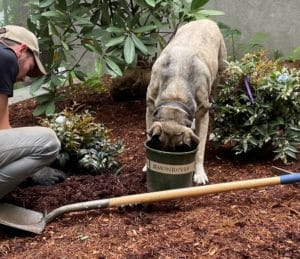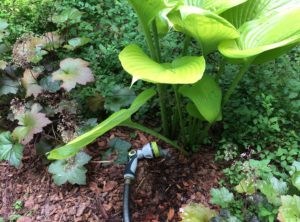Hello fellow readers, I adore helping clients design their gardens, procure plants, and place them, and now is a busy time. Last week was such fun working with Kathy and Sean of Shohola, PA, and their rescue dog Hank, who inspected the empty pots by sticking his head inside. Perhaps to ensure we removed plants properly (smile)? Then comes coaching on watering their new plant babies. The first two years are critical in helping them become established in their new home.

Hank the “inspector” :^)
Watering protocols for new plants:
It’s best to water the roots and avoid wetting leaves. Only forty percent of the water from sprinklers gets to the plant’s roots where it’s needed. Using less wasteful drip soaker hoses or hand watering is far better.
The key is the keep the soil moist. Moisture should get six inches deep for annuals and perennials and twelve inches deep or more for shrubs and trees. I equipped Kathy and Sean with a nifty moisture meter probe (about 15 bucks) to help take away the guesswork.
Early evening, before 6 PM, is the best time to water, so leaves have time to dry before nighttime. And it allows the plants to absorb the moisture through the night before the drying sun and heat of the next day. But if you have to use sprinklers, early morning is best, so leaves have all day to dry to reduce the likelihood of foliar disease. And it gives the plants time to absorb the water before it evaporates.
New plants should be watered daily for the first two weeks if Mother Nature doesn’t provide. Water new plant babies every two or three days in weeks three through twelve. Then weekly after that.
Too much water is just as damaging as not enough.

Kathy & Sean’s Home “Before”

Kathy & Sean’s Home “After”
Irrigation systems are a huge convenience with new plantings. But once established, frequent use can encourage plants to become shallow-rooted and less tolerant of drought. While plants prefer consistent moisture, letting the soil dry out a little before watering encourages deeper (better) root growth.
Too much water is just as damaging as not enough. Roots need to breathe, and over-watering or too thick mulch, more than three inches, will suffocate roots, causing plant demise or failure.
Leaf curl, which looks like wilting, can be a symptom of too much water. Also, leaves can wilt in extreme heat and sun even if the soil is moist. It’s a natural way to protect themselves from aspiration (evaporation from the leaves).
Recall that proper planting protocol is to dig a hole twice the width and the height of the root ball. Water directly over the root ball, and be sure to water the backfill soil to encourage roots to grow into it.
Be sure to keep the soil evenly moist. Watering only one side of the plant will cause one-sided root growth. If water starts running over the ground, it’s too much water at one time. Move the hose and come back after it soaks in.

Use a slow stream or soaker setting from your garden hose.
How much water depends on the plant’s size.
How much water depends on the plant’s size. For trees, a good rule of thumb is one to one and a half gallons per inch caliper. Caliper is the trunk’s width six inches above the ground if less than a 4-inch caliper tree and twelve inches above for more than 4-inch caliper trees. So for a two-inch caliper tree, use two to three gallons of water.
For shrubs and perennials, figure the volume of water to use is a third of the container they came in. Maybe that’s what Hank was inspecting? I’ll expect his full watering report when I visit :^). Garden Dilemmas? AskMaryStone@gmail.com (and your favorite Podcast App.)
For more New Plant Baby Tips, tune into Episode 59 of the Garden Dilemmas Podcast
More tips on watering plants:
- Mulch drastically helps run-off and evaporation— natural mulch, please, NOT the dyed kind, and no more than 3 inches thick. Dyed mulch is often made of recycled wood filled with chemicals that can impact plant health. Black mulch is particularly stressful for plants is it heats the soil and foliage, adding more need for water.
- Why Landscape Fabric is a No-No – While landscape fabric seems like a good idea for weed control, it prevents water and nutrients from absorbing and causes the plants to have shallow roots. Plus, weeds grow in decaying mulch anyway.
- *A long-ago column on the topic (featuring my family :^)you’ll enjoy – A Landscape Fabric Intervention!
- Tree-gators, nifty watering bags, can simplify watering a newly planted tree, but it takes management. If there’s plenty of rainfall, don’t fill the tree gator. And if it’s accessively hot and dry, the bag may need to be filled more than once a week.
- Another helpful technique for trees is to make a three-inch ring of soil along the edge of the root ball. Set the hose at a trickle to fill the reservoir, slowly allowing the water to permeate the roots. Arbor Day Foundation has a wonderful article on How to Properly Water Your Trees



Hi Mary!
It’s Melinda, (Carolyn’s friend) not sure if you remember me but we enjoyed a wonderful hike together last summer on the Tripod Rock trail.
Just want you to know that I truly love reading your column! Wonderful and useful information with lots of extra meaning :))
You are a great inspiration! Keep it going!
Warm regards
Of course, I remember you, Melinda! That was an eventful day scrambling through the rocks :^). Thank you for taking the time to share your kind words about my column. I am pursuing the dream of converting it into a book that comes with more self-doubt than I’d like to admit. Your comments lift my heart. So grateful, Mary